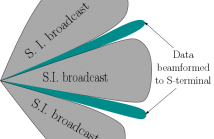
- Read more about Mirror-Prox SCA Algorithm for Multicast Beamforming and Antenna Selection
- Log in to post comments
This paper considers the (NP-)hard problem of joint multicast beamforming and antenna selection. Prior work has focused on using Semi-Definite relaxation (SDR) techniques in an attempt to obtain a high-quality sub-optimal solution. However, SDR suffers from the drawback of having high computational complexity, as SDR lifts the problem to higher dimensional space, effectively squaring the number of variables.
- Categories:
 13 Views
13 Views
The transceiver separations required for synthesizing full rank MIMO matrices in line of sight (LoS) geometries scale as the square root of the product of carrier wavelength
and range. The wavelengths at millimeter (mm) wave carrier frequencies are small therefore enable LoS spatial multiplexing with practical node form factors at ranges of 10-100 m, depending on the carrier frequency. However, such LoS MIMO links become frequency selective even with small geometric mismatches. Exact channel inversion in an
- Categories:
 23 Views
23 Views
- Read more about Efficient Techniques for Broadcast of System Information in mmWave Communication Systems
- Log in to post comments
In this paper we consider Millimeter wave (mmWave) Massive MIMO systems where a large antenna array at the base station (BS) serves a few scheduled terminals. The high dimensional null space of the channel matrix to the scheduled terminals is utilized to broadcast system information to the non-scheduled terminals on the same time-frequency resource.
- Categories:
 46 Views
46 Views
- Read more about Efficient Techniques for Broadcast of System Information in mmWave Communication Systems
- Log in to post comments
In this paper we consider Millimeter wave (mmWave) Massive MIMO systems where a large antenna array at the base station (BS) serves a few scheduled terminals. The high dimensional null space of the channel matrix to the scheduled terminals is utilized to broadcast system information to the non-scheduled terminals on the same time-frequency resource.
- Categories:
 27 Views
27 Views
- Read more about A Fair Comparison of Virtual to Full Antenna Array Measurements
- Log in to post comments
- Categories:
 3 Views
3 Views
- Read more about Deterministic Annealing for Hybrid Beamforming Design in Multi-Cell MU-MIMO Systems
- Log in to post comments
Abstract—This work deals with hybrid beamforming (HBF)
for the MIMO Interfering Broadcast Channel (IBC), i.e. the
Multi-Input Multi-Output (MIMO) Multi-User (MU) Multi-Cell
downlink channel. HBF is a low complexity alternative to fully
digital precoding in Massive MIMO systems. Hybrid architectures
involve a combination of digital and analog processing that
enables both beamforming and multiplexing gains. We consider
BF design by maximizing the Weighted Sum Rate (WSR) for
the case of Perfect Channel State Information at the Transmitter
- Categories:
 16 Views
16 Views
- Read more about Interference Management via User Clustering in Two-Stage Precoder Design
- Log in to post comments
We consider a single cell downlink (DL) massive multiple-input multiple-output (MIMO) set-up with user clustering based on statistical information. The problem is to design a fully digital two-stage beamforming aiming to reduce the complexity involved in the conventional MIMO processing. The fully digital two-stage beamforming consists of a slow varying channel statistics based outer beamformer (OBF) and an inner beamformer (IBF) accounting for fast channel variations.
SPAWC2018.pdf
- Categories:
 20 Views
20 Views
- Read more about Rate-Splitting for Multi-group Multicast Beamforming in Multicarrier Systems
- Log in to post comments
In this work, we consider multi-group multicast transmissions with different types of service messages in an overloaded multicarrier system, where the number of transmitter antennas is insufficient to mitigate all inter-group interference. We show that employing a rate-splitting based multiuser beamforming approach enables a simultaneous delivery of the multiple service messages over the same time-frequency resources in a non-orthogonal fashion.
- Categories:
 13 Views
13 Views
- Read more about Rate-Splitting for Multi-group Multicast Beamforming in Multicarrier Systems
- Log in to post comments
In this work, we consider multi-group multicast transmissions with different types of service messages in an overloaded multicarrier system, where the number of transmitter antennas is insufficient to mitigate all inter-group interference. We show that employing a rate-splitting based multiuser beamforming approach enables a simultaneous delivery of the multiple service messages over the same time-frequency resources in a non-orthogonal fashion.
- Categories:
 24 Views
24 Views